Panel 1
Loretta Lattanzi, Luisa Nicoletti
In Italy, the coasts, which develop for over 8,000 km, represent an important strategic resource: they are among the most densely populated areas and home to intense economic activity. The increasing exploitation to which these areas are subjected, associated with natural events (e.g. global climate change), has led to an increase in erosion phenomena. To counteract these processes and to protect housing and infrastructure, over the years numerous rigid defense works have been carried out in several coastal regions (surfaces emerged, submerged, grazing, mixed works, piers, brushes), not always with satisfactory results. An alternative technique that could guarantee a good response to coastal erosion, from an environmental and economic point of view, is replenishment. The replenishment consists in reconstructing the eroded beach by entering suitable sediments (from the granulometric and compositional point of view). A possible response to the need to supply material to be used for replenishment has been identified in the use of relict marine sands (referenced to paleopiagge) from sandy deposits present offshore on the continental shelf. The first dredging of rewashed sands for replenishment began in 1995 in the northern Adriatic Sea (Veneto). Subsequently, other dredgings have affected both other quarries located in the Adriatic Sea (off Emilia-Romagna and Marche) and both quarries located in the Tyrrhenian Sea (off the coast of Sardinia and Lazio).
Most of the Italian coasts are subject to erosive phenomena mainly due to an imbalance in the sedimentary balance of the beaches. This budget, which regulates the methods and rate of growth and erosion of the beaches and which must be referred to a significant period of time (e.g. one year), depends on the relationship between the "incoming" material (offstocks) and the "outgoing" (loss). The contributions are mainly made up of the sediments carried in charge by the rivers and redistributed by the coastal currents and those coming both from the disintegration of rocky coasts, and by the erosion of nearby beaches. The losses, on the other hand, are due to the removal of the material towards the bulk due to the effect of the wave motion and the loss of sediment to the ground. The construction of barrier works for the regulation of the slopes, together with the construction of reservoirs to be allocated to hydroelectric and / or irrigation, have contributed to the significant decrease in sediment contributions by waterways, interfering with the natural erosive processes of the coasts, intensifying them. Other factors such as the tightening of the coastline due to the realization of maritime works, the extraction of fluids from the subsoil, the immobilization and the flattening of the dunes, have contributed to amplify the erosive phenomena. One of the techniques that is able to guarantee a good response to coastal erosion, from an environmental and economic point of view (at least for major interventions), is replenishment through the use of relict sandbox deposits. These materials, located along the continental shelf between 30 and 130 meters deep, are recovered by dredging operations. The use of relict sands to be used for the replenishment of the coasts, compared to the exploitation of material emerged, has some advantages such as: availability of high quantities of sediment (millions of m3), composition potentially very similar to the sand of our coasts, limited effects on the environment and, for replenishments that imply large volumes of materials, low costs. The choice and possibility of dredging relics depend on a number of socio-economic, geological and technical factors. It is, in fact, possible to carry out dredging operations of sands for replenishment purposes only when: along the continental shelf, possibly near the stretches of coastline in erosion, there are actually deposits of relict sands; the deposit is "exploitable" in general terms (oftens of the hair cover, depth of the deposits etc.) (BEACHMED, 2004); the relics have been identified in the original naturalization of the natural goods. A last aspect to consider is linked to the fact that the handling of large volumes of sediment involves a considerable commitment, both in technical-design and economic terms, not always sustainable.
Fornire informazioni relative alla quantità di sabbie relitte dragate ai fini di ripascimento lungo la piattaforma continentale italiana. Fornire, inoltre, indicazioni indirette sui fenomeni erosivi agenti nelle regioni italiane considerate.
The regulatory framework in force in Italy, specific for the dredging activities of the sands carried out for the purpose of replenishment, is still partially in progress. The replenishment with wrecked sands is governed by the Ministerial Decree of 24 January 1996 (instructory activities for the issue of the authorization) and by Law 31 July 2002, n.179, which defined for authorizations the passage of competences from the State to the Regions. The Law n.179 of 31 July 2002 established, in fact, in Article 21 (authorization for interventions to protect the coastal strip) that the body responsible for investigating and issuing the authorization pursuant to art. 35 paragraph 2 of Legislative Decree 152/1999 (now art. 109 D.Lgs. 152/2006) on the replenishment of the coastal strip is the region. Where material from the sea board excavation is used for replenishment, the region, at the start of the authorisation investigation, shall obtain the opinion of the Fisheries Advisory Commission and inform the MiTE at the start of the investigation. The region, moreover, in order to verify the possible environmental impacts caused by the dredging activities of sands for replenishment purposes, it must present an application for subjectibility to SEA and VIA in the regional sector pursuant to art. 6 of Legislative Decree no. 4/2008. The aforementioned decree, in fact, inserts in Annex IV (Projects subject to the verification of subjectibility of competence of the regions and autonomous provinces of Trento and Bolzano) the "coastal works intended to combat erosion and maritime work aimed at modifying the coast, through the construction of dams, moles and other works of defense of the sea".
Panel 2
Nicoletti L., Paganelli D., Gabellini M. (2006) - Aspetti ambientali del dragaggio di sabbie relitte a fini di ripascimento: proposta di un protocollo di monitoraggio. Quaderno ICRAM n. 5: 159 pp. Grande V., Proietti R., Foglini F., Remia A., Correggiari A., Paganelli D., Targusi M., Franceschini G., La Valle P., Berducci M.T., La Porta B., Lattanzi L., Lisi I., Maggi C., Loia M., Pazzini A., Gabellini M., Nicoletti L. (2015). Sistema Informativo per il monitoraggio ambientale della risorsa sabbia offshore nei progetti di protezione costiera: geodatabase env_Sand., ISPRA vol. MLG 127/2015, p. 1-63, ISBN: 978-88-448-0742-9 Nicoletti L., La Valle P., Paganelli D., Lattanzi L., La Porta B., Targusi M., Lisi I., Loia M., Maggi C., Pazzini A., Proietti R., Gabellini M. (2018) - Aspetti ambientali del dragaggio di sabbie relitte a fini di ripascimento: protocollo di monitoraggio per l’area di dragaggio. ISPRA, Manuali e Linee Guida 172/2018, 32 pp. ISBN: 978-88-448-0877-8
Data quality assessment
Coastal regions
The data are requested from time to time to the competent administrations that authorize or perform the work (the subject can also be a private individual). There is no agreed mode for data retrieval.
national
1994-2022
Indicator assessment
The cubic meters reported are the basic data.
non definibile
Since 1994 and 2004 there has been a considerable volume of dredged wrecked sands, used for the replenishment of several beaches in the coastal resorts in the province of Venice (over 7,000,000 m3). Also along the Lazio coasts (cave of Anzio, Montalto and Torvaianica), between 1999 and 2012, large quantities of relic sands (over 7,800,000 m) were dredged. Minor interventions were carried out in Emilia-Romagna in 2002, 2007 and 2016, off the Gulf of Cagliari (2002) and off the Marche region (2006). In 2022 an additional 1,080,000 m3 of sands off Emilia-Romagna (cable off Ravenna) were dredded. Between 2008 and 2011, 2013 and 2015 and 2017 and 2021 there were no relic sand dredging interventions along the Italian continental shelf (Table 1). It is emphasized that the lack of dredging interventions for the purpose of replenishment is not an indication of the absence of erosion phenomena. It is known, in fact, that the choice and the possibility of making such dredgings depend on a number of socio-economic, geological and technical factors.
Data
Table 1: Volumes of slapped sands dredgers for replenishment along the Italian continental shelf
ISPRA
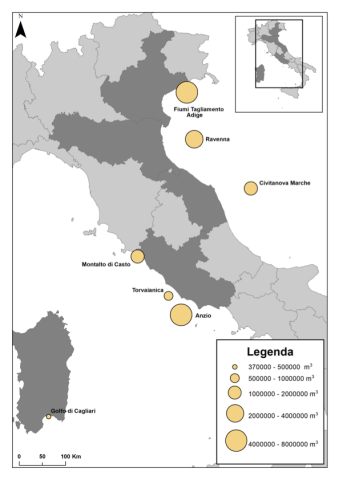

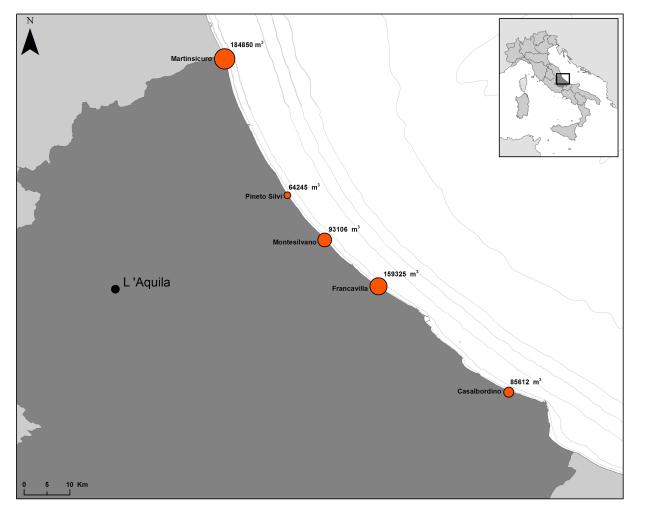
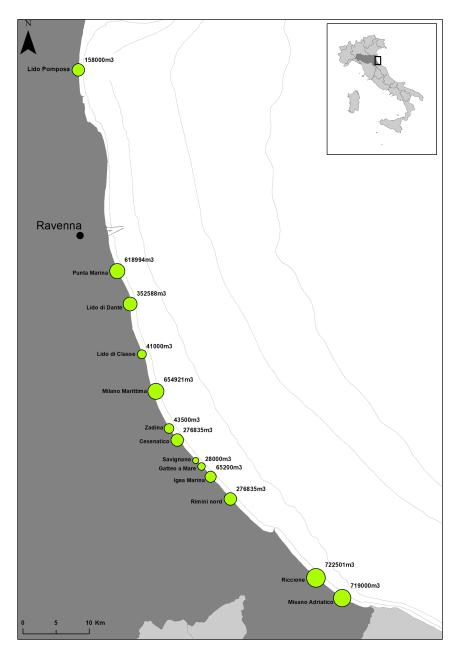


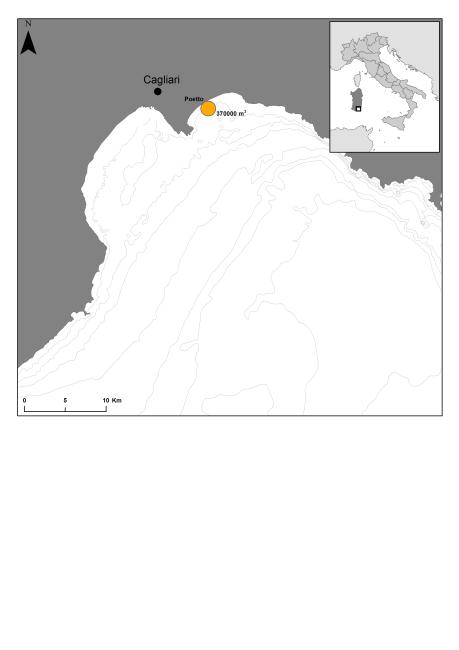
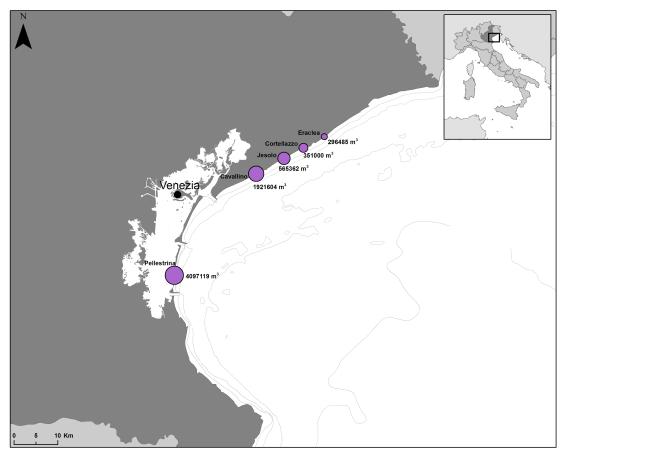
In Italy (Figure 1) the first dredging activities of relict sands date back to 1994 and were carried out by the Magistrate at the Acque of Venice for the repasting of the beaches of Cavallino and Pellestrina (Venice). Since 1994, about 7,000,000 m3 of sand have been used from a deposit offshore between the mouths of the rivers Tagliamento e Adige at about 20 m deep (Figure 2). In the central Adriatic Sea, dredging of rewashes for replenishment purposes, were conducted off Ravenna (2002, 2007, 2016 and 2022) by the Emilia-Romagna Region (Figure 3) and off Civitanova Marche (MC) (Figure 4-5) by private individuals (2006). In the Tyrrhenian Sea the first activities of dredging sands for replenishment purposes, conducted by the Lazio Region, were those concerning the exploitation of a deposit of wrecked sands present off Anzio (Rome), used for the replenishment of the coast of Ostia in 1999. The Lazio Region has therefore started a series of dredging sands for replenishment purposes that has affected both the aforementioned quarry of Anzio, and two other deposits, located off Montalto di Castro (VT) and Torvaianica (Rome) (Figure 6). Finally, dredging activities were conducted, in Sardinia, off the Gulf of Cagliari (2002) by the province of Cagliari (Figure 7).